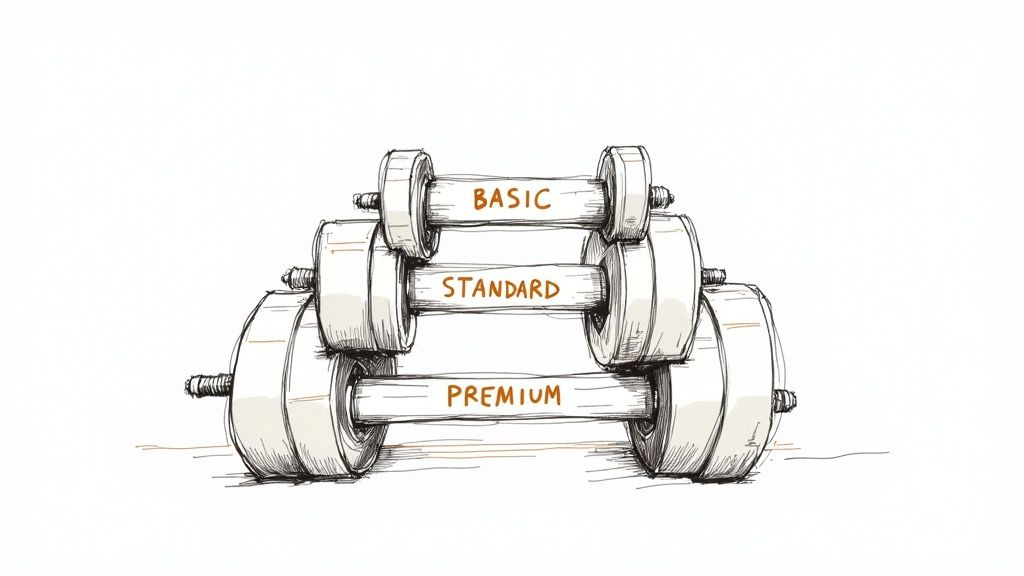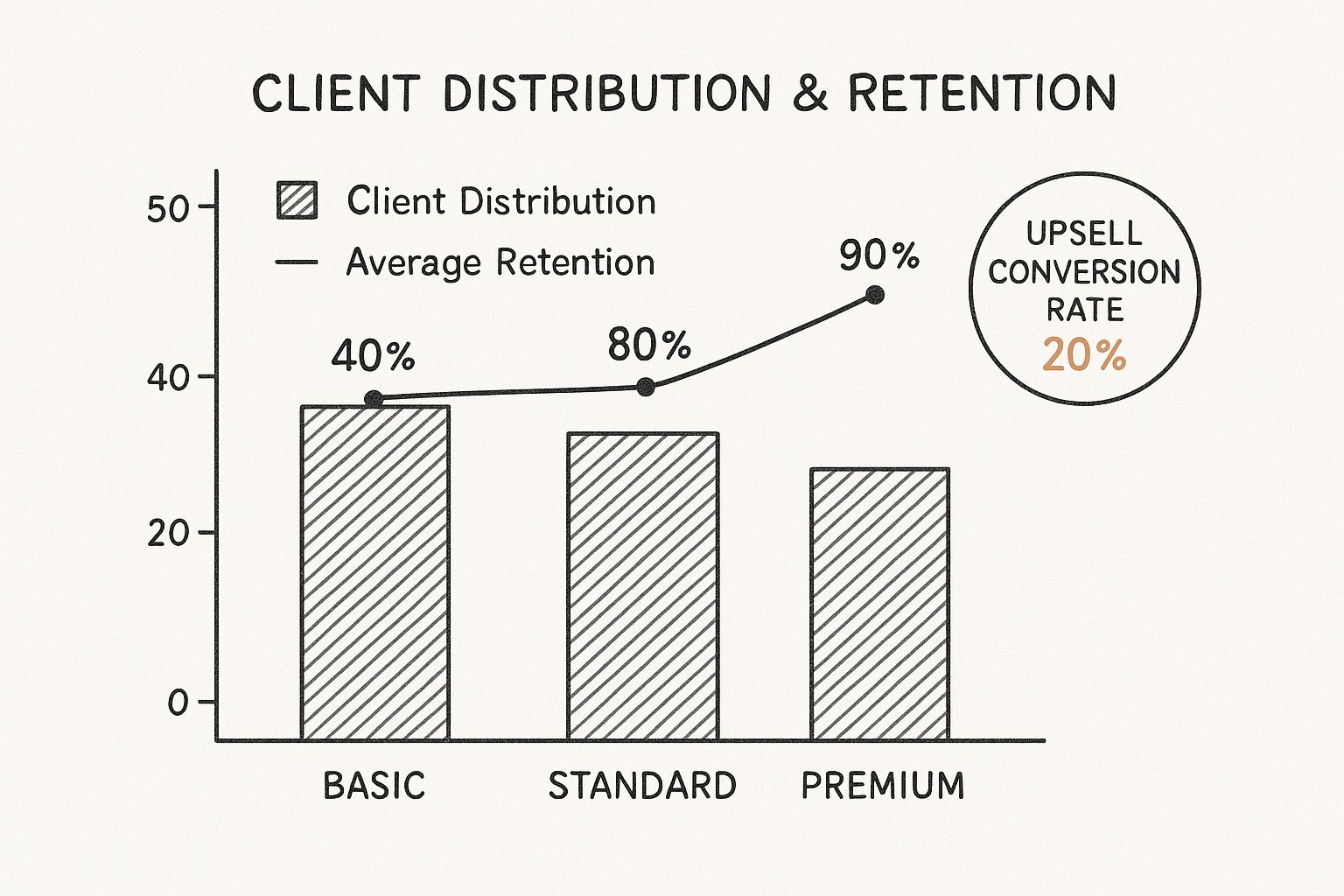Launch profitable online fitness coaching programs with this guide. Learn to design, market, and scale your digital coaching business with proven strategies.
This article is proposed by Gymkee, the personal trainer software that allows you to deliver the best coaching experience to your clients while saving time and growing your personal training business.
Try Gymkee for free for 14 daysOnline fitness coaching is the delivery of personalized workout plans, nutrition guidance, and accountability to clients through a digital platform. It’s personal training without the geographical limits, using technology to deliver results.

The fitness industry has shifted. What was once a niche offering is now a standard expectation. Clients want flexibility that a traditional gym schedule cannot provide. This isn't about replacing in-person training; it's about meeting clients where they are—at home, traveling for work, or on their own schedule.
This shift created a significant market opportunity. The global online fitness market grew from approximately $6 billion in 2019 to nearly $60 billion in 2023, according to Grand View Research. This growth is driven by consumer demand for convenience.
A key insight from the market data is that a large percentage of subscribers are new to fitness services entirely. This indicates online coaching is expanding the market, not just converting existing gym members.
Modern clients are not buying a workout PDF. They are investing in a structured solution to their problems, delivered by a coach who understands their lifestyle. They expect a clear path to their goals without the friction of in-person appointments.
This means a coach's role has expanded beyond exercise programming to include:
The most successful online coaching programs are built on communication and support. Clients retain with coaches who make them feel seen, heard, and guided, regardless of physical distance.
The operational differences between traditional and online coaching are significant.
This table clarifies that the online model is a different business structure, not just a digital version of in-person training.
The online model removes traditional constraints for trainers. Geographic barriers and the time-for-money exchange are eliminated. Instead of being limited by the number of hours you can be on a gym floor, you can serve clients globally and build scalable income streams.
Going digital allows you to design a coaching experience that reflects your specific coaching philosophy, expertise, and brand.
If you're ready to make this transition, the first step is to understand the logistics of how to start an online fitness business. This is the new standard in a client-centric fitness industry.

An effective online fitness program is a structured solution to a specific person's problem. Generic, one-size-fits-all plans lead to poor results and negative client feedback. The foundation of a high-value program is specialization.
Attempting to coach everyone results in connecting with no one. Focus on a niche you understand and enjoy working with.
Who do you serve best?
Are you an expert in postpartum strength recovery for busy mothers? Do you have a system for helping desk workers alleviate chronic back pain? Or do you specialize in training runners for their first half-marathon?
Selecting a specific niche provides clear advantages:
Specialization shifts the competitive frame from price to expertise. Your marketing becomes more efficient because you know exactly who you are targeting and what their needs are. This focus is the first practical step to building a differentiated online coaching program.
Profitable coaching businesses are built on getting the right clients incredible results, not on having the most clients. Specialization is the fastest path to attracting your ideal client.
Once you know who you’re serving, build offers that meet them at different financial and commitment levels.
Not every potential client is ready for a high-ticket, intensive coaching package from day one. Offering tiered packages creates multiple entry points and provides a clear upgrade path as clients see results and build trust.
Consider a three-tiered structure:
This model allows you to capture a wider audience. A client might start with the Starter plan, achieve good results, and then upgrade to the Pro package for more personalized attention, maximizing the lifetime value of each client.
The final step is to build the training framework. For programs to be scalable, your system must balance customization with efficiency.
Start by creating "base" templates for your niche—for example, a 12-week fat loss program or a 16-week strength-building cycle. From this foundation, you can quickly adjust variables like exercise selection, volume, and intensity for each client. This approach delivers a custom experience without requiring you to start from scratch every time, saving significant administrative time.
The right technology streamlines your coaching business; the wrong technology creates friction and unnecessary costs. Building an effective online fitness program depends on tools that support your workflow. You do not need the most expensive, feature-heavy platform to deliver a premium client experience.
A simple, lean setup is often more effective than a bloated system where you only use 10% of the features. The objective is to find a stack that handles the essentials—client management, payments, and program delivery—so you can focus on coaching.
The primary decision is whether to use an integrated, all-in-one platform or assemble your own system from individual tools.
Solutions like Trainerize or TrueCoach bundle all necessary features into a single application. They provide a professional, branded client experience out of the box, which is a significant advantage. However, they come with a recurring monthly fee that can be a considerable expense for a new business.
The alternative is a "Do-It-Yourself" (DIY) stack, combining several affordable or free tools to perform the same core functions. This approach offers maximum control and minimizes overhead.
A lean DIY stack could consist of:
The DIY method requires more initial setup time but can save hundreds of dollars annually. It demonstrates that a powerful coaching program does not require a large budget. For a deeper analysis of software options, see this guide to online personal training platforms.
Your tech stack should grow with your business. Start with what's essential and affordable. Invest in more advanced tools only when the return on investment is clear. Overspending on software is a common mistake that stalls new coaching businesses.
Understanding your client distribution across service tiers can inform your tech budget decisions. This chart shows a typical distribution and its correlation with retention rates.

The data indicates that higher-priced, premium tiers not only attract more committed clients but also tend to have significantly better retention. This information helps you decide if a premium platform that enhances the high-touch experience is a worthwhile investment.
The choice of tech stack depends on your business model.
If you plan to scale with a high volume of clients on a standardized program, an all-in-one platform is often a sound investment. The automation and streamlined management can save dozens of hours per month.
Conversely, if you focus on high-touch, premium one-on-one services for a smaller client roster, a lean DIY stack is more suitable. It provides the flexibility for a deeply personalized experience without the constraints of a platform's structure.
The best technology is the one you will use consistently to get results for your clients.
This comparison covers popular platforms used by coaches today.
The "best" platform is subjective. What works for a coach with 500 group clients may be excessive for a coach with 15 high-ticket clients. Use your business model as your guide, start lean, and invest in more powerful tools as your revenue grows.
You can build the most effective fitness program, but it is useless if no one knows it exists. Effective marketing is not about generic social media posting; it's about crafting a clear message that addresses the specific problems and goals of your ideal client.
The objective is to build trust. You achieve this by consistently providing valuable content that solves small problems for your audience, which demonstrates your ability to solve their larger ones.
Simple, authentic content is your most effective marketing tool. People buy from coaches they know, like, and trust. You build this relationship by sharing expertise and showcasing real-world results.
Your content strategy should focus on three core areas:
Learning how to create effective video advertisements can also be a valuable skill for turning passive social media users into qualified leads.
Your content's primary function is to answer the questions your ideal client is already searching for online. When you do this consistently, you become the logical choice for a coach.
Focusing on providing genuine value attracts a pre-qualified audience. The sales process then becomes a natural next step rather than a high-pressure pitch.
When a potential client has a call with you, they are looking for a conversation, not a sales pitch. They need to determine if you understand their problem and can guide them to a solution. Your role is to diagnose their issue and present your program as the most direct solution.
Structure your calls to be collaborative.
This approach positions you as a trusted advisor, not a salesperson. The call should end with a clear and confident invitation to join, making the decision straightforward for the client and setting them up for commitment and success.

Acquiring a client is the first step. Retaining them is how you build a sustainable business. A superior client experience is your primary tool for retention. It turns a one-time customer into a long-term client who provides referrals. This experience begins at the moment of sign-up.
A disorganized start can demotivate a client before their first workout. A seamless onboarding process, however, immediately validates their decision to invest in your online fitness coaching programs.
The first week is critical. Your objective is to eliminate confusion and build immediate momentum. Do not just email a program and hope for the best. Implement a structured onboarding sequence that welcomes the client, gathers necessary information, and clarifies the next steps.
A robust onboarding system includes these three components:
For a detailed guide, refer to these client onboarding best practices. A solid onboarding process prevents future problems.
Consistency is the foundation of a strong coaching relationship. You need a reliable system for weekly check-ins that is efficient for both you and your client.
A structured weekly check-in process looks like this:
A short, personal video provides more effective feedback than text. It conveys tone and encouragement in a way that builds trust and connection.
This structured approach ensures no client is overlooked and allows you to batch your check-ins into a single, focused block of time.
The power of community should not be underestimated. Even if you primarily offer one-on-one coaching, a private group for your clients (on Facebook, Slack, or within your coaching app) is a valuable asset. It provides a space for them to share successes, ask questions, and support each other.
This sense of belonging increases long-term engagement. It transforms your service from a simple transaction into an experience where clients feel part of something larger. This community becomes a powerful retention tool.
As you build your online fitness programs, you will encounter challenges and questions. Here are answers to some of the most common ones.
This depends entirely on your coaching model. There is no single correct answer.
If you are running a high-touch, fully bespoke one-on-one service, your capacity will likely be around 15-20 clients. Exceeding this number can lead to burnout and a decline in service quality.
If you are using a semi-personalized or group coaching model, your capacity can be much higher. Coaches can effectively manage 50, 100, or more clients at once using templated programs combined with group calls.
Start with a small number of clients. Perfect your systems and client experience before scaling up.
Legally, the online coaching industry is largely unregulated, so a certification is not technically required to start. However, operating without one is a significant business risk.
A reputable certification (from an organization like NASM, ACE, or Precision Nutrition) provides three critical assets:
While not a strict legal requirement, getting certified is a non-negotiable business decision. It builds client trust, protects you from liability, and provides the confidence to deliver a professional service.
Stop charging by the hour. You are selling a transformation, not your time.
Price your coaching as a complete package, typically on a monthly recurring basis. This shifts the client's focus from the number of hours they receive to the results they can achieve.
Research what other coaches in your niche are charging, but do not simply copy their prices. Your price should reflect the unique value and transformation you deliver. A solid starting point for a comprehensive online coaching package is often between $199 to $499 per month. This can and should be adjusted as you gain experience, collect testimonials, and refine your service.
Do not be afraid to charge what you are worth. Your pricing should reflect the life-changing results you provide.
Ready to build, manage, and scale your coaching business without the headache? Gymkee provides all the tools you need—from a lightning-fast workout builder to integrated nutrition coaching and seamless client management. Save hours on admin and deliver a world-class experience that keeps clients coming back. Start your 14-day free trial today.
This article is proposed by Gymkee, the personal trainer software that allows you to deliver the best coaching experience to your clients while saving time and growing your personal training business.
Try Gymkee free for 14 days